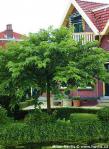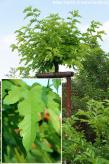Morus alba ('Platanifolia Fruitless') 'FRUITLESS'

Morus alba ('Platanifolia Fruitless') 'FRUITLESS'
white mulberry, plane-leaved mulberry
white mulberry, plane-leaved mulberry
| SIZE/TYPE | small tree |
|---|---|
| USUAL HEIGHT | 3-5m |
| USUAL WIDTH | 3-5m |
| LEAVES | deciduous broadleaf |
| COLOUR OF LEAVES |
 green green |
| FLOWERS | insignificant or non-blooming |
| LOCATION | full sun |
| SOIL TYPE | neutral to alkaline |
| SOIL MOISTURE REQUIREMENTS | evenly moist but well-drained |
| USDA zone (lowest) | 4 (down to -34°C) |
| WINTER PROTECTION | |
| FOR ZONE 5+6 |

|
| FOR ZONE 7 |

|
| BELONGS TO CATEGORIES |
Deciduous broadleaf Trees Exotics |
White mulberry is considered to have originated in China but its natural distribution is widespread all around mild and subtropical parts of Asia including India. We, Europeans, know it, too, as it has been cultivated from the ancient times. For instance, Dalmatian orchards were famous for growing large fields of mulberry trees for production of sweet fruits that contained not only sugars but also vitamins and minerals highly beneficial to human health. And since the berries were easily dried, people could store a sufficient stock of healthy food until the next harvest. No wonder mulberry is now rated a superfood. In the warmest areas, it is cultivated as a farm for silkworms from whose fibers (excreta) 95% of all commercial silk is produced.
Plane-leaved mulberry has many admirers thanks to its almost exotic large leaves. Fruitless is a follow-up variety from Italy eliminating the only set back this tree may have when it comes to cleanliness: it is sterile (male) and does not produce fruit that would cause coloured waste under its canopy. It makes large, sycamore-like, distinctly lobed leaves which resemble fig leaves owing to their unique outline. They are deciduous, deep green, highly glossy, commonly 3-lobed, up to 30 cm long and 15-17 cm wide. It is interesting that young leaves are perfectly ovate to narrowly heart-shaped in spring, and only with the arrival of summer, the new leaves produced at the tips of the branches are borne lobed. In the spring the tree wakes up later than most other deciduous trees. If the autumn is nice and long, without premature frosts, the leaves turn yellow briefly before falling off. However, it often happens that they remain green on the tree for a long time and the first light frost turns them brown. From July ripen small, dark red to almost black fruits - edible mulberries, about half of which fall off before maturity.
This variety does not grow very tall and makes a an impressive, spreading, umbrella-like canopy. You can often find a rather romantic bench under the tree where you can enjoy relieving shade in summer heat. Shape, size, and growth rate of the canopy depends on pruning. If you cut back previous year’s growths by up to 80 %, leaving only some 20 cm of the branch length, the tree will make long new branches (50-120 cm) and deeply lobed leaves with be larger and appear earlier in the season. The canopy will be more horizontal with slightly drooping branch ends. Do so in early spring after the worst frosts but before the buds begin to swell. Unpruned it will grow about 30 cm per year both in height and spread and the canopy will be dome-shaped.
White mulberry loves sunny and warm places, yet it is very cold tolerant. It will grow in almost any well-drained soil, but will grow faster and be healthier in deep, moderately fertile, neutral to alkaline soil. It does not mind heavy clay deeper in the ground. Newly transplanted trees need a strong support (staking) for the first 3-4 years before they establish and keep the area above roots turf-free and preferable mulched during this period. It has shallow roots that do not disturb foundations or pavements but does not tolerate road salt. It is considered middle-aged, and its life span is often compared to that of humans. Reliably hardy to -34 °C and tolerates temporary fluctuations down to -37 °C if it has mature wood. (USDA zone 4-5).
Last update 07-02-2024
Plane-leaved mulberry has many admirers thanks to its almost exotic large leaves. Fruitless is a follow-up variety from Italy eliminating the only set back this tree may have when it comes to cleanliness: it is sterile (male) and does not produce fruit that would cause coloured waste under its canopy. It makes large, sycamore-like, distinctly lobed leaves which resemble fig leaves owing to their unique outline. They are deciduous, deep green, highly glossy, commonly 3-lobed, up to 30 cm long and 15-17 cm wide. It is interesting that young leaves are perfectly ovate to narrowly heart-shaped in spring, and only with the arrival of summer, the new leaves produced at the tips of the branches are borne lobed. In the spring the tree wakes up later than most other deciduous trees. If the autumn is nice and long, without premature frosts, the leaves turn yellow briefly before falling off. However, it often happens that they remain green on the tree for a long time and the first light frost turns them brown. From July ripen small, dark red to almost black fruits - edible mulberries, about half of which fall off before maturity.
This variety does not grow very tall and makes a an impressive, spreading, umbrella-like canopy. You can often find a rather romantic bench under the tree where you can enjoy relieving shade in summer heat. Shape, size, and growth rate of the canopy depends on pruning. If you cut back previous year’s growths by up to 80 %, leaving only some 20 cm of the branch length, the tree will make long new branches (50-120 cm) and deeply lobed leaves with be larger and appear earlier in the season. The canopy will be more horizontal with slightly drooping branch ends. Do so in early spring after the worst frosts but before the buds begin to swell. Unpruned it will grow about 30 cm per year both in height and spread and the canopy will be dome-shaped.
White mulberry loves sunny and warm places, yet it is very cold tolerant. It will grow in almost any well-drained soil, but will grow faster and be healthier in deep, moderately fertile, neutral to alkaline soil. It does not mind heavy clay deeper in the ground. Newly transplanted trees need a strong support (staking) for the first 3-4 years before they establish and keep the area above roots turf-free and preferable mulched during this period. It has shallow roots that do not disturb foundations or pavements but does not tolerate road salt. It is considered middle-aged, and its life span is often compared to that of humans. Reliably hardy to -34 °C and tolerates temporary fluctuations down to -37 °C if it has mature wood. (USDA zone 4-5).
Last update 07-02-2024
SIZES and PRICES
GLOSSARY
|











